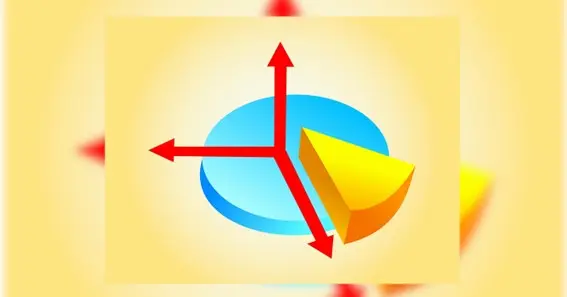What is magnitude in physics? The size or amount of a physical feature is called magnitude in physics. This essential inquiry introduces a fundamental principle in many physical sciences. It is crucial for discussing real-world qualities like force, speed, acceleration, and energy. It would help if you comprehended the magnitude of how things and forces interact. This in-depth article will explain what is magnitude in physics, its utilization, and its importance in physics.
What Is Magnitude In Physics?
Magnitude in physics means absolute number or amount. Direction shows how a vector points, whereas scale shows size. This is crucial when working with vectors, which have size and direction. Velocity describes both speed (magnitude) and direction. Force magnitude and direction are the quantity and direction of force, respectively. Physicists can measure and compare physical objects’ sizes by isolating magnitude without considering direction. This short briefing should have given you a basic understanding on what is magnitude in physics.
Calculating Magnitude

Know you know about what is magnitude in physics, next let’s calculate it. Formulas are needed to calculate magnitude, especially with vector numbers. Using the Pythagorean Theorem, find the size of a vector shown by its components in a coordinate system. To see the size of a two-dimensional vector with x and y components, take the square root of the sum of the squares of its sections (√(x² + y²)). The magnitude of a three-dimensional vector is calculated by multiplying its elements by √(x² + y² + z²). This method is needed to calculate vector sizes appropriately in many practical applications with higher dimensions.
Various Application Of Magnitude In Physics

Many fields utilize magnitude to represent the size or range of physical things. Physics uses magnitude to quantify forces, speeds, and accelerations. This explains how things move and interact. It helps plan and research circuits and communication systems by determining electric and magnetic field sizes in electromagnetism. The magnitude of stars, planets, and other celestial objects indicates their brightness and distance from Earth. Seismology measures earthquake size to determine energy release and impact. Because of these uses, magnitude helps scientists and engineers comprehend and use the real world.
Magnitude In Classical Mechanics
Magnitude is crucial to understanding how things move and interact in classical physics. Newton’s laws of motion depend on force, which has a size and direction. Force magnitude impacts speed and acceleration. Like a force, its work relies on how far it moves an object. Kinetic energy is another essential concept related to speed. These scenarios demonstrate how magnitude measures physical qualities that govern behavior in classical mechanics.
Magnitude In Electromagnetism
Size matters when discussing electric and magnetic fields and their forces in electromagnetism. The length of an electric field indicates its strength at a given position, which affects its attraction to charged particles. The size of a magnetic field indicates its strength and impacts charged particle movement. Ohm’s law links magnitudes, voltage, current, and resistance. The voltage drop across a conductor depends on its current and resistance. Understanding electromagnetic magnitudes helps us predict and control electrical and magnetic phenomena.
Magnitude In Wave Phenomena
Size also matters for sound, light, and water waves. Amplitude affects wave strength and energy. The amplitude magnitude of sound waves indicates their loudness, whereas light waves indicate their brightness. Magnitude describes wave parameters like wavelength and frequency. Wave speed indicates how fast a wave passes through a substance. These sizes help scientists predict how different waves would behave in other materials.
Magnitude In Quantum Mechanics
In quantum mechanics, magnitude changes while dealing with probabilistic events. Wave function size determines the probability of locating a particle in a specific state. This chance density, given by the square of the wave function magnitude, is crucial to understanding quantum particle behavior. Motion and energy are measured with magnitude in quantum systems. Understanding these sizes helps scientists understand quantum phenomena that are often puzzling. It bridges the gap between complex mathematical explanations and visible things.
Magnitude In Relativity
Both particular and general relativity explain spacetime and movement using magnitude. Special relativity accelerates objects toward the speed of light as their energy increases. This generates relativistic time stretching and length contraction. Lorentz transformations maintain spacetime gap sizes. The speed of light remains constant. The strength of gravitational fields modifies spacetime curves and how items and light move in general relativity. These usages demonstrate how magnitude is crucial to understanding relativity in the cosmos.
Conclusion
In conclusion what is magnitude in physics, magnitude is a fundamental physics concept that specifies physical size or range. In many fields, it’s crucial. Quantum mechanics, electromagnetism, and relativity use magnitude. This number explains and compares physical features, revealing more about the cosmos. By separating magnitude from direction, physicists may accurately measure and evaluate vector quantities, anticipate physical system behavior, and connect theoretical and real-world concepts. As you investigate the physical world, magnitude remains central to scientific investigation. This was a brief article on what is magnitude in physics for you to understand.
FAQ
What Does Physics Call Magnitude?
In physics, magnitude is the size or amount of physical property like force, speed, or energy without considering direction.
How Do You Calculate Vector Size?
The Pythagorean formula calculates vector magnitude. A vector having parts (x, y) has a magnitude of √(x² + y²). The magnitude of a vector having parts (x, y, z) is √(x² + y² + z²).
What Does Size Signify In Classical Mechanics?
Size matters in classical mechanics for calculating kinetic energy, force strength, and force work.
What Does Magnitude Have To Do With Waves?
Magnitude controls wave amplitude, such as how loud sound or light waves are. It impacts wave speed, too.
How Is Magnitude Related To Quantum Mechanics?
Quantum mechanics calculates the likelihood of finding a particle in a state based on a wave function’s probability density. This is crucial to understanding quantum systems.
Sources:










